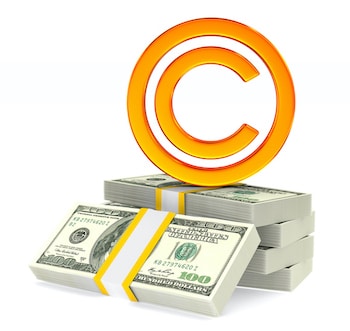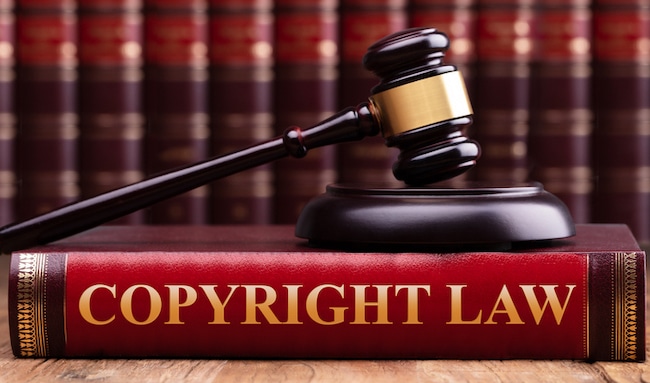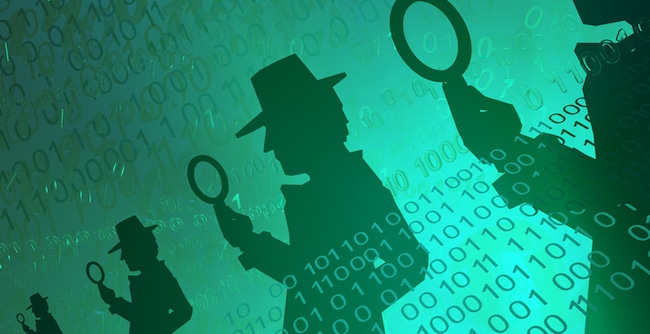Menu
January 8th, 2020
We all know the phrase “a picture is worth a thousand words,” but did you know using a picture the wrong way could also be an expensive mistake, or worse? One of our clients, unfortunately, found this out the hard way when they unknowingly published a copyrighted photo in a light-hearted blog post a few years ago and was charged $1000 by a copyright enforcement agency.
In this post we’ll be discussing what you can and can’t do regarding images and art found on the internet, how to steer clear of trouble, how to find material that is free to use, and how to respond if you get in trouble.
Special Thanks! This post is the result of collaboration between The Modern Firm client and intellectual property attorney Stephen Joncus, TMF contract blog writer David Wells, and TMF Owner, Brendan Chard. We want to give an especially big thank you to Stephen for his time, deep knowledge and contributions to this extensive and informative post.
Using Pictures on Your Blog is Good — But You Must Have Rights to Use Them!
Using images in online writing is a good practice for a variety of reasons. On the technical side of things, it can help with SEO. On the artistic and usability side of things, text combined with photographs, diagrams, or illustrations is more pleasing to the eye than a wall of text. Finally, as the saying goes, a picture is worth a thousand words. When it comes to choosing images, though, proceed with caution. Unless you are one hundred percent responsible for creating an image, and everything in the image, and you can prove that, you need to be certain that you have the right to use that image. This means you need to know a bit about copyright law and some related topics.
Think Copying a Photo or Stock Art Won't Be Noticed? Think Again!
To underscore how important this issue is, if you use a copyrighted image in an online article or blog post without permission, you could be liable for copyright infringement. You may think that, in the vast sea of the internet, copying one little photo or stock image (that you may have even seen on multiple other websites) will certainly go unnoticed. At a minimum, who would care, right? Wrong. The internet is now home to companies, such as PicRights and Copytrack, that crawl the web on behalf of copyright owners, looking for unauthorized use of their images. If they think that you are infringing on a copyright, as was the case with our client, they will demand payment. It is possible to negotiate a settlement with these companies, but it is better to avoid the problem altogether.
A Quick Primer on Copyright Law
A “copyright” is the right to exclude others from using a creative work, such as a photograph, drawing, painting, illustration, book, article, novel, song, or poem. A copyright owner can publish, broadcast, exhibit, perform, or display a copyrighted work. They can grant licenses to others to use a copyrighted work in specific ways. Unauthorized or unlicensed use of a copyrighted work is known as “copyright infringement.”
What Do Copyrights Protect?
Federal law extends copyright protection to “original works of authorship fixed in any tangible medium of expression.” This includes almost anything that can be expressed in writing or other visual form, or as a recording.
Copyright does not cover ideas. A person who has the idea to create a musical work using the sequence of digits in the number Pi (i.e. 3.1415926535897…) to inspire the sequence of notes, cannot protect that idea with a copyright. See Erickson v. Blake, 839 F. Supp. 2d 1132, 1139 (D. Or. 2012). What is copyrightable is the expression. Characteristics of the expression in the work, like the choice of scale, rhythm, harmony and embellishments are protected by copyright. Consequently, a work using folk instruments does not infringe a copyright in a symphonic work notwithstanding the fact that both used the same idea to sequence the notes based on Pi.
In the case of photographs, a copyright owner has the exclusive right to reproduce, distribute, or to create derivative works. If a photograph depicts copyrighted material, such as a photograph of a sculpture or painting, the photographer may need permission from the owner of that copyright.
Who Owns a Copyright?
A person who creates an original work automatically owns a copyright in that work in most cases. One major exception is when a person creates something as a “work for hire.” An employee who is hired to draw Batman for DC Comics does not own the copyright in those drawings, because they are creating them as part of their job. An employee whose job it is to create copyrightable works does not own the copyright to works they create for an employer. In these cases, the employer owns the copyright. But if one hires an independent party to paint a picture, write software, or tattoo a body part, the artist will own the copyright in the work unless the contract for the work also assigns the copyright to the hiring party. That’s why when you hire The Modern Firm to design your web page or write your text, we expressly assign our copyright in your web page to you.
A copyright for a photograph could belong to the photographer, an employer of the photographer, or an assignee of the photographer, such as a news agency or photography clearing house like Getty Images. In the case of our client, the copyright in the photograph they used was owned by a news agency.
Copyright Registration
The definition of what is copyrightable is broad–virtually anything fixed in a tangible medium is protected by copyright. For example, your Post-It notes on your desk or computer screen are likely all protected by copyright under federal law. But the copyright in copyrightable works is of little practical value, unless it is registered with the U.S. Copyright Office, because registration is a prerequisite to enforcement of a copyright. Before a copyright owner can file a lawsuit, their copyright must be registered with the U.S. Copyright Office. And the Supreme Court recently ruled that a copyright owner must wait for the registration to issue before filing suit–merely applying for a registration is not enough. Fourth Estate Public Benefit Corp. v. Wall-Street.com, __ U.S. __, 139 S. Ct. 881 (2019).
Copyright Licenses for Photographs
Using a copyrighted photograph requires a license from the copyright owner. Most stock images can be licensed for a one-time fixed fee. Unlike most stock photos, a license to photos from famous photographers usually require payment of periodic royalties to the copyright owner depending on how the photograph is being used. Copyrights that can be acquired for a one-time fixed fee–called “royalty free” images–are usually vastly more affordable than copyrights that require periodic royalty payments. We’ll cover more on this later. But keep in mind, “royalty free” does not mean “free;” it just means that the copyright license does not require periodic payments to maintain the license.
Companies like Shutterstock, iStockPhotos and Getty Images license stock photography, video and other content for a one-time fixed fee. They generally provide information on how to obtain a license, and what uses are permitted with different licenses. The two most common licenses for copyrighted photographs are described as editorial or commercial use. Although “editorial use” and “commercial use” are not legal terms, these are terms that are commonly used by stock photography companies to describe the extent to which a licensee is given permission to use the photograph.
Commercial Licenses
Commercial licenses allow broader use than editorial licenses. As a result, they have stricter requirements, and often cost more. With a commercial license, you may use a photograph to advertise a product or service, such as on a billboard, in printed marketing materials, or on a business website. This includes the use of a photograph in most blogs and other online publications.
A commercial license requires signed releases from every recognizable person, and the owners of every recognizable property or copyrighted work in the photograph. The photograph cannot have any visible trademarks, such as company or product logos. Most companies that provide stock photography obtain all of the required releases and keep them on file. They can then certify to anyone purchasing a license that their photographs meet the requirements for commercial licenses.
Editorial Licenses
Photographs with an editorial license cannot be used to sell anything. They can only be used for editorial or educational purposes, such as in newspapers, on news programs, or in textbooks or other educational materials. They do not have the trademark restrictions found in commercial licenses.
Fair Use, and Why It’s Best as a Last Resort
The Fair Use Doctrine allows limited use of copyrighted materials for specific purposes, such as educational commentary or parody. The important point you should know, for our purposes here, is that Fair Use is a defense to copyright infringement. It is something you would bring up in a court of law to avoid liability for damages. It is not something that can prevent an infringement lawsuit in the first place.
If you infringe a Copyright you might face very aggressive enforcement.
As we mentioned earlier, numerous companies offer automated web-crawling services to copyright owners, which allow them to find infringement of copyrighted photos on the internet. The tactics that some of these companies use may appear to be overly aggressive and unfair. Some have even complained online that PicRights borders on extortion in their demand letters. But, from a copyright owner’s perspective, the high cost of litigation and low damage awards often make it unaffordable to police widespread infringement of their work.
Copyright Litigation
The only way for a copyright owner to force an infringer to stop using its copyrighted work and collect damages for the infringement is through litigation. In a copyright infringement lawsuit a court can issue an injunction to prevent further infringement and award monetary damages. Often copyright owners opt for statutory damages because actual damages are usually difficult to prove. Statutory damages for the infringement of a single copyright range from $750 to $30,000 per work. If the infringement is willful, statutory damages can be as high as $150,000 per work.
But filing lawsuits is an expensive business. So do not be surprised if you face a demand for $10,000 for infringement of an image that you could have licensed for $20. In view of the cost of litigation, that would not be an outrageous demand. And if you are a sophisticated party (like a lawyer or small business) and you copied a photograph from somewhere else to put on your website, the copyright owner’s attorney will assert that your conduct was willful to threaten the prospect of statutory damages up to $150,000.
Fights like these are so easy to avoid. There is really no excuse for not purchasing a license for an image that you want to use on your website or marketing materials. "Unfortunately, Internet users often have the impression that the Internet is free and that they are entitled to use information from the Internet for free. Others might rationalize that it’s such a small thing, that they are likely to get away with it. Don’t be that person. Buy a license,” says copyright attorney, Stephen Joncus.
Copyright Enforcement Agents
Because litigation is expensive, there are now companies that provide a service for copyright owners by crawling the web with automated systems looking for infringement on behalf of their clients. They document the infringement by capturing screenshots and then reach out to the infringer by email and/or letter. One of the largest enforcement agents is PicRights and they represent some large international copyright holders, such as the Associated Press. Another large player is CopyTrack. It might actually be your lucky day if you are caught by a copyright enforcement agent who is willing to settle a copyright infringement claim. While their demands, which frequently seem to be in the range of $750-$5000, might seem like a lot in comparison to the price that you could have paid to license the photograph, such a settlement is much more preferable than being served with a federal lawsuit and the much higher settlement demands that will accompany the litigation.
If you do get contacted by a copyright enforcement agent, you should consult with an attorney. Assuming that you know that the infringement allegation is valid, you want to settle as cheaply as possible, but you don’t want to pay a fraudster who is not acting for the actual copyright owner. In other words, in exchange for a payment, you need to get a release from the actual copyright owner. There are ways to write settlement agreements that give you some assurance that you are getting a valid release, and you should consult with your attorney on how to protect yourself.
Negotiate, Negotiate, Negotiate
If you know that the allegation is valid and you used the image in support of a business that seeks to make a profit, you most likely will want to settle because it is unlikely that you will have a viable defense. But as with everything else, you can try to negotiate a better deal. To get an idea of a workable range start by figuring out what the proper license should have cost in the first place.
When is a copyright enforcer a copyright troll?
The term “copyright troll” is common parlance, but are you facing a copyright troll? Is merely demanding, what you consider to be an unfair amount of money, the sign you are dealing with a “copyright troll?” No. Properly viewed, a copyright troll is doing something else to abuse the system. Remember, even if you are an unintentional infringer, federal law expressly provides for up to $30,000 in statutory damages per work infringed. Copyright infringement is a serious offense. Copyright owners take it seriously and the tools provided by federal law are necessary to enable copyright owners to protect their copyright. If you are facing a very high demand to settle, you might be unlucky to be facing aggressive enforcement, but if you infringed the copyrighted work, you are in the wrong, not the copyright owner.
But abuse does occur. A common form of abuse is known as BitTorrent litigation. BitTorrent is a computer protocol for sharing computer files among multiple computers. There are BitTorrent websites that allow users to share the necessary data to view a movie for free. People who use these sites are usually unsophisticated. While the copyright owners of a movie are entitled to enforce their copyright, the mechanisms that are used to identify that a certain person has infringed are unreliable. Additionally, there have been situations where BitTorrent plaintiffs actually did not own the copyright that they purport to enforce. This type of litigation usually is lawyer driven, and is a means to make money for the lawyer–not to deter infringement. Lastly, the targets of these enforcements are usually unsophisticated, and cannot afford to defend themselves. Such parties, who assert questionable claims against people who are unable to defend themselves to make money for the lawyers, deserve the label of copyright troll. Another fact pattern involves mass lawsuits alleging illegal downloading of pornographic films. Such plaintiffs uses the stigma of pornography to extort settlements from accused infringers also deserve the pejorative label of copyright troll.
By and large, if you copied an image for your website without a license and have been caught, you are not facing a copyright troll.
How to Avoid Copyright Problems on Your Website in the First Place
The solution to all these problems is simple. Pay for a license to the photos, videos and other media that you want to use on your website.
Royalty-Free, Creative Commons, and Public Domain Photos
The internet has multiple resources for photographs that do not require the ongoing payment of royalties, or that do not require any payment at all. Sites that offer royalty-free stock photos allow you to stop worrying about payment once you have purchased a license. For example, iStockphoto and ShutterStock charge a one-time fee in exchange for a license that allows unlimited use of the photograph. They also offer monthly bulk plans for website design agencies such as The Modern Firm and this is how we obtain much of the artwork for our law firm websites. Other sites may have different license terms.
If you are looking for free images, the options available are likely to be very disappointing. Free images are usually not suitable for use on a professional website. But they are available on sites such as pexels.com, unsplash.com, creativecommons.org, and pixabay.com. Royalty free licenses for images can be obtained from iStockPhoto.com, Dreamstime.com, Shutterstock.com, and Adobe (stock.adobe.com).
Please note, Google Image Search is NOT a free image source. And it is unlikely to be an efficient way to find images that can be licensed.
What if You Haven’t Been Caught Yet?
If you are using unlicensed images or media on your website, you are inviting an unpleasant confrontation. Any unlicensed photos should be removed immediately. The image files should also be removed from the server. On WordPress websites, this can be done using the “Media” manager. The image should not be accessible in any way from your website address. Finally, use the resources listed above to seek out suitable alternative photographs.
Plagiarism Checkers
Photographs are not the only way that bloggers can find themselves in trouble with copyright owners. In addition to causing failing grades on school papers, plagiarism can also lead to liability for copyright infringement. This could occur even with unintentional plagiarism. Websites like CopyScape can tell you if your text matches other text on the web, and how much they match each other. This can also help SEO on your site, since it tells you if you are duplicating content found elsewhere.
Armed with all of this information we hope you now have enough working knowledge to be able to safely blog and publish to your heart’s content. If you’d like help with blogging for your law firm, please check out our writing service page where you can learn about our process and view writing samples. (We provide fully licensed images to all of our blogging clients free of additional charge!) And, if you have a question you’d like answered here on our blog, feel free to submit it here.
Categories: Question of the Week








